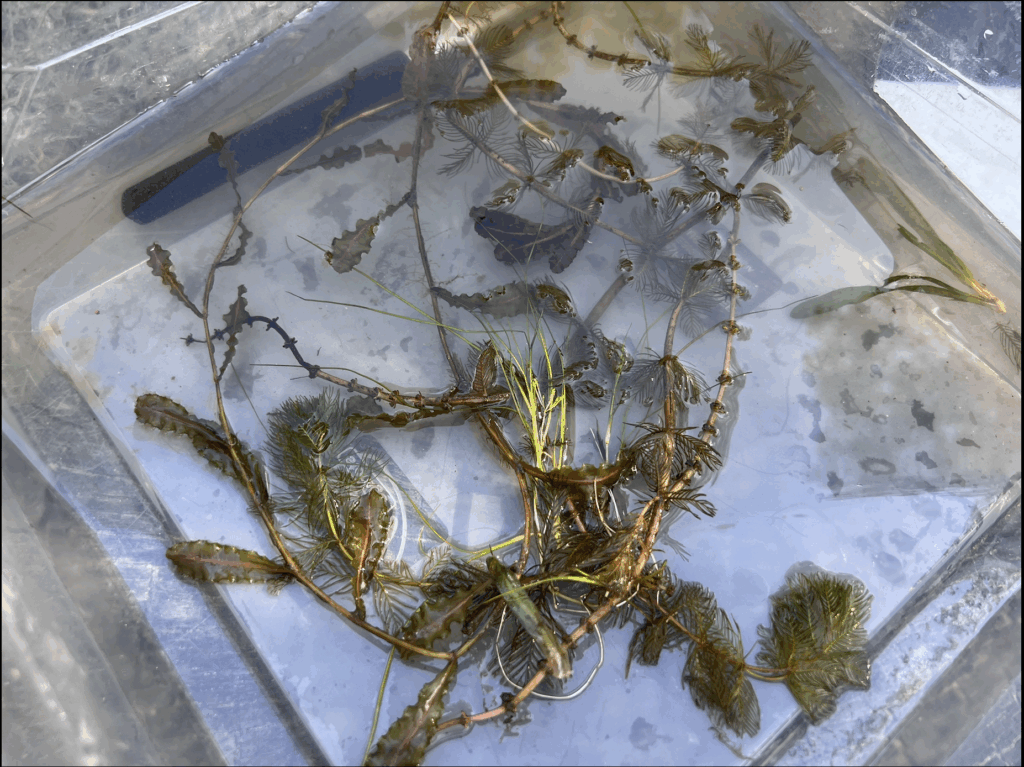
On October 2nd 2025 Gunpowder RIVERKEEPER® staff and volunteers met at the Hammerman beach house to take part in training provided by the state of Maryland Department of Natural Resource’s (MDNR) Brooke Landry, Kaitlin Scowen, and Erika Koontz on Submerged Aquatic Vegetation (SAV). Their organization Chesapeake Bay SAV Watchers has been tracking the population of these plants in the bay for the last thirty years using aerial photography and subsequent ground-truthing: where citizen scientists can help out by documenting populations of SAV species.

Their mission is to protect and expand existing SAV beds which provide vital food and habitat for Bay species not limited to blue crabs, shellfish, game fish, and waterfowl. The message is clear: if people want to help crab populations (and other delicious or fun-to-hunt creatures), they need more SAV. Unfortunately, human interference in the Bay’s ecosystem has caused drastic reductions in the range and distribution to these essential organisms. Estimates of historic coverage of SAV in the Chesapeake range from 400,000 to 600,000 acres. Current coverage only measures roughly 84,000 acres. SAV Watcher’s ultimate goal is to restore up to 196,000 acres of SAV, 114,000 acres of which fall within the state of Maryland.


SAV is very reliant on large quantities of sunlight. When water quality is reduced, such as from sediment or pollutant runoff, the turbidity goes up and water clarity goes down. Then the plants can’t get enough light. Plants can also be out competed for light by harmful algae blooms, which often result from fertilizer or animal-waste runoff. Fortunately, since the Pollution Diet restrictions on the Bay were instituted 2014, SAV has experienced a healthy resurgence, indicating that the protection and conversation efforts are helping.

Also present at the training was Ray Terracina from Smithsonian Environmental Research Center (SERC) who provided information and training on the Chesapeake Water Watch program. This program monitors the turbidity of the Bay’s water via satellite imagery and checks the data collected by the satellites against photos and water samples collected by citizen scientists. Since the turbidity levels directly affect a plant’s ability to photosynthesize, and since both programs offer opportunities for the public to help crowdsource the data, these presentations couldn’t have been a more perfect match.

After the classroom portion the day concluded, participants shuttled over to the Dundee Creek Marina to test our methods first-hand, by submitting photos of the water turbidity to the Hydrocolor app and by paddling out to find and identify three different species of SAV. Despite the lateness of the season and the high water level, we were able to collect samples of Curly Pondweed, Widgeongrass, and Eurasian Watermilfoil. The latter of which, though technically non-native, is still beneficial to the ecosystem: any SAV is better than no SAV.

For the Gunpowder River specifically, the goal is to reach 2,432 acres of SAV coverage. In 2023 we had 208 acres of coverage. The Tidal Gunpowder, the part of the river concerning the Chesapeake Bay SAV Watchers, is divided into two segments: GUNOH1 aka the “mouth” of the river as it meets the bay, and GUNOH2, the tidal river basin between the fall line and roughly Maxwell Point. Both of these segments fall into the Oligohaline section of the bay, meaning that they have relatively low salinity compared to the more brackish zones. Since fresher water has the potential for more diverse species of SAV, the Tidal Gunpowder is a key area for mapping the extent and diversity of SAV species.

Gunpowder RIVERKEEPER® has already been actively participating in the Chesapeake Water Watch program by analyzing samples and documenting photos but now we have also been trained to train others in monitoring SAV. Anyone who is interested in participating in this citizen science and helping to collect the data used to analyze, preserve, and protect the Chesapeake, including tributaries like the Gunpowder, should keep any eye out for future trainings on our website and social media, or pop into Sparks Bank Nature Center to chat with us about our new favorite topic.

